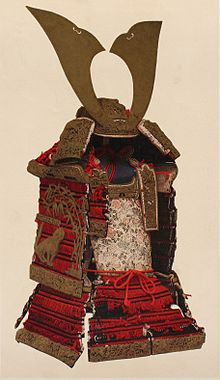 Global Information
Global InformationJapanese armour information

Scholars agree that Japanese armour first appeared in the 4th century, with the discovery of the cuirass and basic helmets in graves.[1] During the Heian period (794-1185), the unique Japanese samurai armour ō-yoroi and dō-maru appeared.[2] The Japanese cuirass evolved into the more familiar style of body armour worn by the samurai known as the dou or dō, with the use of leather straps (nerigawa), and lacquer for weatherproofing. Leather and/or iron scales were also used to construct samurai armours, with leather and eventually silk lace used to connect the individual scales (kozane) of these cuirasses.[3]
In the 16th century, Japan began trading with Europe, during what would become known as the Nanban trade. This was the first time matchlock muskets were imported, and as they became mass-produced domestically, samurai needed lighter and more protective armour. As a result, a new style of armour called tosei-gusoku (gusoku), which means modern armour, appeared.[3] When a united Japan entered the peaceful Edo period, samurai continued to use both plate and lamellar armour as a symbol of their status.
Ōyamazumi Shrine is known as a treasure house of Japanese armour. It houses 40% of Japanese armour that has been designated as a National treasure and an Important Cultural Property.[4][5] Kasuga Grand Shrine is also known as a treasure house of valuable armour.[6]
Every year on Children's Day, May 5, Japanese households display miniature samurai armor and kabuto (helmets) in keeping with the tradition of Tango no Sekku. In feudal times, real samurai armor, kabuto, and tachi were displayed.[7][8]
- ^ Farris, William Wayne (1998). Sacred Texts and Buried Treasures: Issues in the Historical Archaeology of Ancient Japan. Honolulu, Hawaii: University of Hawaii Press. p. 75. ISBN 0824820304. Retrieved 13 March 2016.
- ^ 式正の鎧・大鎧 Costume Museum
- ^ a b 日本の甲冑 Costume Museum
- ^ Yorio Fujimoto, "神社と神様がよーくわかる本" p.65. Shuwa System Co., Ltd. ISBN 978-4798040721
- ^ "Oyamazumi-jinja Shrine – Japan's Most Extensive Samurai Treasury". Retrieved 2019-06-04.
- ^ Kasuga-taisha Museum
- ^ 五月人形と鯉のぼりの由来 (in Japanese). Nagoya Japanese Sword Museum Nagoya Touken World. Archived from the original on 4 February 2023. Retrieved 4 February 2023.
- ^ 五月人形の基礎知識 (in Japanese). Nagoya Japanese Sword Museum Nagoya Touken World. Archived from the original on 4 February 2023. Retrieved 4 February 2023.